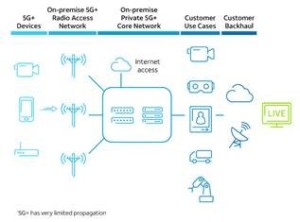February 25, 2022

Related Blogs:
Sign up for blog updates
Get innovation delivered to your inbox. Sign up for our blog and stay on top of the very latest from Semtech (formerly Sierra Wireless).
February 25, 2022

In our blog Should You Build a Private 5G or LTE Network? we address many of the basic questions facing business and IT leaders when they are considering whether they should deploy a private 5G or LTE network.
However, once they have made the decision to deploy a private 5G or LTE network, the next question becomes which specific devices to choose for their network. The organization will need to decide on a radio access network (RAN), mobile core, cellular router, and end-user devices (see Figure 1). These will all depend on the use case for the private network. Will the devices be connecting industrial machines, automated guided vehicles (AGVs), grid infrastructure, rugged handhelds or other IoT edge devices to their private cellular network?

Figure 1: AT&T Private Cellular Networks
One key element of the network is the cellular router. The router enables communications between the end-user device and the cellular network.
According to Omdia in their Private LTE and 5G Network Enterprise Survey Insight-2021 survey results, the top three drivers for private networks are 1) security, data management and privacy 2) workforce productivity and 3) support wider enterprise digitization. The least important for the respondents was enabling new revenue services/revenue streams.
With these drivers in mind, organizations that are implementing private networks should consider routers that:
One of the first questions enterprises should ask is “based on how I’m going to use the private network, should I choose an LTE or 5G router?”
Now that several cellular routers have been certified by US carriers, most enterprises are looking at 5G routers to deliver faster speeds and lower latency. This was enabled by 5G New Radio (NR) including the Ultra-Reliable Low Latency Communications (URLLC) capabilities with Release 16 of the 5G standard.
To maximize the data speed, latency, and other performance capabilities of these 5G network technologies, organizations look for very high up and downlink speeds. For example, the XR Series from Sierra Wireless provides a minimum downlink data speed of 4.14 Gbps and uplink data speed of 660 Mbps with less than 10 milliseconds (ms) of latency.
For companies that want to future-proof their router investment, there are multi-network routers that can be deployed on an LTE network today, and can be upgraded or migrated to a private 5G network in the future.
As highlighted in the Omdia survey, many enterprises are exploring private networks to support wider digitization throughout their organization, whether that is on the factory floor, at a multi-modal port, in a subway station or other industrial and commercial environment.
Putting an enterprise router in a high-temperature, high vibration, and high moisture environment could fail prematurely. Business and industrial routers must be rated and tested to operate at high and low temperature extremes, high humidity, and high shock and vibration environments. If used in a vehicle or powered by batteries, routers must survive high and low voltage extremes as well as high transient voltage spikes.
To meet rugged environments, enterprises should select routers that feature die cast aluminum housing that is sealed to meet IP64 and Mil-STD 810G for resistance to dust and water ingress.
Security is top of mind for most businesses and industries these days. A few questions to ask are:
Routers should be designed to protect the data as it is generated and moves from the edge to cloud. These security features include HTTPS, secure socket, secure boot, firmware over-the-air (FOTA) updates, end-to-end data encryption and support for up to multiple concurrent VPN sessions.
Select routers from Sierra Wireless also include “root of trust” features that unique hardware-based cryptographic keys that provide additional router security, whether the router is booting-up or connecting to the cloud.
Private 5G cellular networks are proving to be an attractive option in shipping ports, airports, mining companies, warehouses, and manufacturing plants that need high-reliability coverage, increased security, and better flexibility. When deploying a private network, it’s important to ensure the 5G router supports the spectrum being used for the private network.
Look for a router that works on the private network bands the enterprise is using today, but also plan for future bands. These include those currently available in Europe (such as the 3.4–3.8GHz band for private 5G networks in Germany and the 2.57-2.62 GHz band in France) and North America (such as the 3.5 GHz CBRS band in the United States).
Managing tens or hundreds of devices is much more complex than managing a handful of devices. Enterprises should choose a solution that delivers a simplified approach to device management and updates. They also need to consider if the management solution gives them the ability to evaluate the entire router fleet performance from a single pane of glass.
Organizations should look for an intuitive interface that provides access to live system data when configuring and managing the routers and allows changes to router parameters and other updates in near real-time, reducing router administration time and costs.
In addition, look for an over-the-air Out-of-Band Management (OOBM) feature which enables enterprises to manage routers via a global IoT network using a Low Power Wide Area (LPWA) modem integrated into the device. This OOBM feature provides an LPWA-based “link of last resort” that can be used to remotely provision, configure, manage, recover, reboot, and update the routers, even if it is not able to use its primary public or private cellular 5G or LTE network connections – helping to minimize downtime and avoid expensive technician visits.
Enterprises can easily take advantage of one of the unique benefits of private LTE and 5G networks – the ability for routers to connect to both the private and public cellular networks.
If the application is mission-critical in mobile environments, such as for first responders in law enforcement, fire, or EMS, no one can afford delay times when switching networks. In addition, routers need to identify the best network to use for critical data communications and the lowest cost network for non-critical data.
Look for routers that offer dual 5G radio options, as well as fallback to LTE networks.
By taking advantage of these options and equipping these routers either with dual SIMs (one for the private network, one for a local public cellular network), these routers can seamlessly switch back and forth between the enterprise private 5G or LTE network and public 5G or LTE network. All that is needed is a connectivity plan with the local public network to activate the SIM and ensure it can be used when connected to the public cellular network.
For example, a truck or train car can connect to the factory, port, campus, or other facility’s private network. It can then switch to using public cellular networks after it leaves the facility.
In addition, if the organization is still in the process of building out a private network, or if the private network is disabled, the routers can use public cellular networks as a “backup” connectivity option – helping to ensure “always-on” connectivity for business- and mission-critical IoT applications.
Sierra Wireless’ AirLink XR Series of advanced 5G cellular routers were developed to meet enterprise business drivers and the needs outlined. The XR Series offers:
Sierra Wireless brings to the private 5G and LTE network router deep cellular connectivity expertise, having been a pioneer in this market since 1997, when Sierra launched the world’s first cellular embedded module.
Since then, Sierra Wireless has also been first to market with many technology solutions in the cellular market, including the world’s fastest, lowest power, and smallest cellular modules; intelligence at the edge with integrated embedded processing and an open-source application framework; cloud-managed 4G LTE routers and gateways; embedded smart SIMs with flexible connectivity options, and the world’s first multi-network 5G vehicle router.
Sierra Wireless has also been actively participating in 3GPP 5G standards meetings for decades, working to ensure the standard is designed and updated to meet the evolving needs of private cellular network owners and operators, as well as other IoT customers. Further, our cellular wireless solutions are used in more than 130 countries, and on more than 600 public cellular networks.
Get innovation delivered to your inbox. Sign up for our blog and stay on top of the very latest from Semtech (formerly Sierra Wireless).